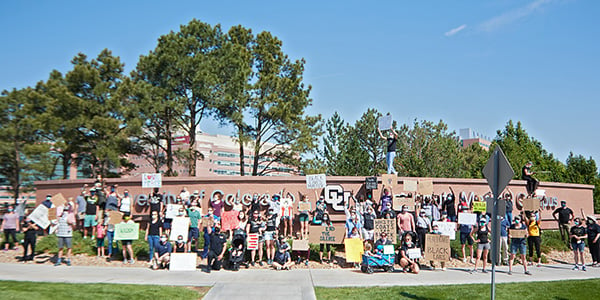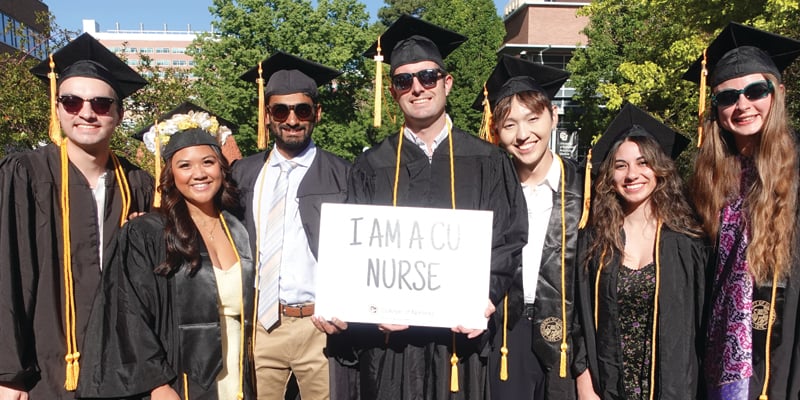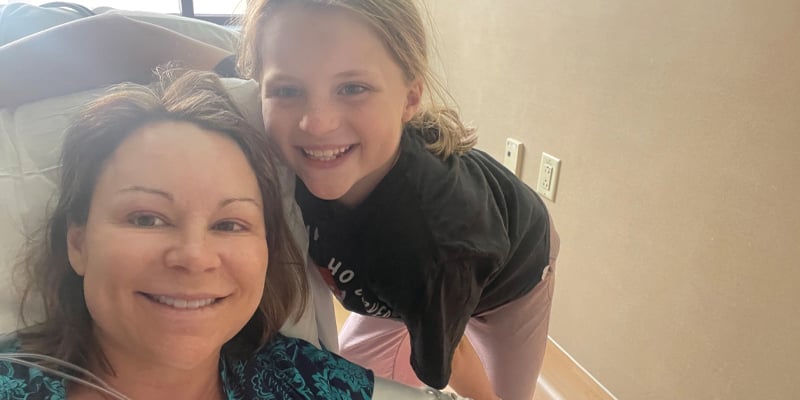Since George Floyd’s killing at the hands of police on May 25, and the senseless deaths of Ahmaud Arbery and Breonna Taylor and others, the country has been struggling with how to support the Black community while demanding change. One thing is clear – something seems different than all the other protests and events that have preceded it. The protests are larger, more vocal, more frequent, diverse, and persistent.
On the University of Colorado Anschutz Medical Campus, students, staff, and faculty have come together to kneel, walk, and talk to support the movement. From a White Coats for Black Lives event where hundreds knelt in solidarity. To a March for Justice organized by CU Nursing students. To lunch and learn town hall sessions between nursing faculty, students and staff, and faculty presented webinars for national nursing organizations highlighting healthcare disparity during COVID-19. Mainstream society has come out in support of Black Lives Matter.
Convergence of Public Health Crises Raises Collective Consciousness
Perhaps it’s the convergence between two public health crises that have brought the necessary attention. Maybe, a pandemic affecting more African Americans than any other population has helped raise a collective consciousness regarding health disparities and implicit bias. For Faculty member Theresa Nino, RN, MSN, “COVID and the death of Black people at the hands of law enforcement have unveiled disparities in health care, the advantage of power and privilege, and the structured racism embedded in our culture. These events have triggered a movement to pursue racial and health care justice.”
How to Achieve Sustained Change Ensuring this is a Movement and Not a Moment
One thing is sure. We have been forced to take a look at ourselves and our society and ask if there is something we can do to help change the trajectory. “No longer can we sit on the sidelines, shake our heads in silence and hope things will change,” said Assistant Professor Susan Bonini. CU Nursing students, staff, faculty, and the general public are asking themselves, “How can we get involved and become part of the solution? Ensuring this time is not just another moment. But that it’s a movement with sustained change,” said Assistant Dean of Student Affairs and Diversity Shane Hoon.
For faculty member Patrick Luna, MSN, a former firefighter and paramedic who was born and raised in Houston, George Floyd’s hometown, it has caused him to look at himself, question his actions and recognize he’s part of the problem and the solution. Young and naïve when he became a firefighter, Luna was instructed to “write down everything the officer tells you. Do not diverge from their account.” He looks back and says, “That was wrong. It took a while to come to grips with what I had done. I needed to make amends and make it better.”
“Recent events have shaken a lot of us to our core,” said Luna. As a faculty member who teaches transcultural nursing theory, Luna realized, “I have to ask myself how am I preparing my students for a new reality? How we train and are trained needs to change.”
Students Demand Change
According to Luna, it’s the students who are demanding and driving a lot of the change. “They want to see that we recognize health disparities in our curriculum and teach something that has been on the back burner for quite some time.” By not calling out the health disparities and the causes, “we are doing a disservice to our communities and the profession.”
Acknowledging that nursing education has a lot more work to do, Luna says the RN credential is a “license to do good in your community and there’s so much more good work to be done.” A big part of being a nurse is one’s cultural background and recognizing that each person is an individual first and not lumped into a racial category or statistic is a basic first step, said Associate Professor Tanya Sorrell who recently presented a webinar on COVID-19 and racial disparities for the American Nurses Association. Available data in areas of the country releasing coronavirus mortality rates show Black Americans have suffered 23% of the COVID-19 deaths despite only representing 13% of the population. Some regions in the South, with larger Black populations, show even greater rates of death in comparison to white people in those areas.
| Learn more about Health Disparities and the Coronavirus |
|
Floyd Beat Coronavirus Only to Die at the Hands of Police
For George Floyd, the “sad irony is that he survived the coronavirus in March only to succumb to the long-established institutional racism pandemic that has been a hallmark of law enforcement and the judicial system,” said Sorrell. The recognition of the ongoing pandemic of racism likely spurred others to join the protests, despite the potential risks of contracting COVID-19.
Nurses are in a unique position to help change the culture. “Part of the new environment involves questioning health equity. How familiar are we with our surrounding community and the people we serve? Nurses can take a more prominent role as we are acutely aware of our patients because we spend the most time with them,” said Luna. This moment is profound for so many people. “All of a sudden an empathy switch has been turned on. We are listening and are seeing all people as humans.”
Being Part of the Solution
How will the College help be part of the solution moving forward? According to students, “We strongly believe that working together to create sustainable change through our actions is important. We truly care about people, how they are treated, and our responsibility for creating better outcomes for the future (especially as nurses).”
Actively speaking against racism and discrimination is one step. “We are in a unique position to teach and role model for our students. Our campus and our students can grow to be community-minded and be a part of the solution for a just new world,” said Nino.
CU College of Nursing faculty, students, staff and the community 'March For Justice'. A peaceful
protest in solidarity of Black Lives Matter and for change across America and within the communities.
For Luna, Bonini, Hoon, Nino, Sorrell, and others it means calling attention to the issue, listening, recognizing, and actively changing how we educate. For others, it might be taking a stand to change the culture and funding of police departments in their communities and reallocate funding to social programs. It may mean calling to disband or change the power structure of police unions and collective bargaining agreements that put the police above the communities they serve. For others, it may mean applying continued pressure on federal, state, and local governments to decriminalize some crimes that disproportionately affect minorities. For a lot of Americans, it means giving a voice for our most vulnerable; no longer remaining on the sidelines and silent.
“This has been a wake-up call. A big part of being a nurse is acknowledging what health means to our patients. We must take into account their culture and experiences. We must learn to listen more, which will directly lead to better and more healthy outcomes for our patients,” said Luna. “One of the gifts of this movement is that people want to listen now. That gives me so much hope for the future.”




